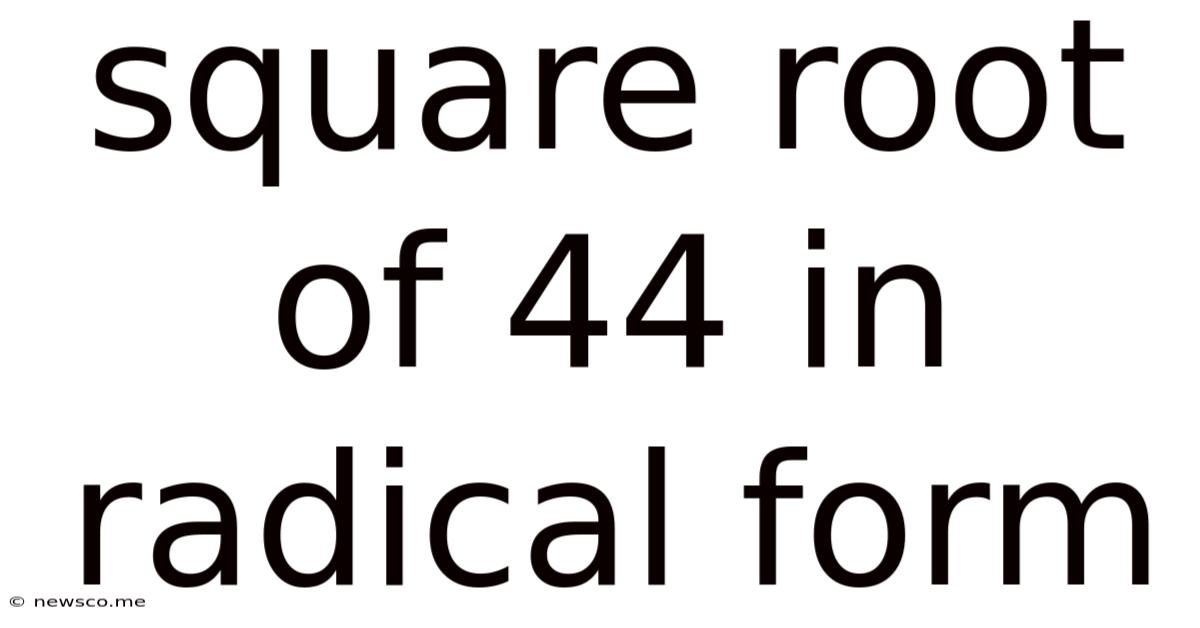Square Root Of 44 In Radical Form
News Co
May 07, 2025 · 4 min read

Table of Contents
Understanding the Square Root of 44 in Radical Form
The square root of 44, denoted as √44, is an irrational number, meaning it cannot be expressed as a simple fraction. However, we can simplify it into a radical form, expressing it as a product of a whole number and a radical. This process involves identifying perfect square factors within the number 44. Let's delve into this process step-by-step and explore related concepts.
Finding Perfect Square Factors of 44
The key to simplifying a square root is to find its perfect square factors. A perfect square is a number that results from squaring an integer (e.g., 4 is a perfect square because 2² = 4, 9 is a perfect square because 3² = 9, and so on). Let's find the prime factorization of 44:
44 = 2 x 22 = 2 x 2 x 11 = 2² x 11
Notice that 44 contains the perfect square 2². This is crucial for simplifying the square root.
Simplifying √44
Now that we've identified the perfect square factor (2²), we can rewrite √44 as follows:
√44 = √(2² x 11)
Using the property of square roots that √(a x b) = √a x √b, we can separate the terms:
√44 = √2² x √11
Since √2² = 2, we get:
√44 = 2√11
Therefore, the simplified radical form of the square root of 44 is 2√11. This is the most concise and accurate representation of the number.
Understanding Irrational Numbers and Radicals
The result, 2√11, highlights the concept of irrational numbers. An irrational number is a number that cannot be expressed as a fraction of two integers. The square root of 11 (√11) is irrational; its decimal representation goes on forever without repeating. Therefore, 2√11 is also irrational.
Radicals, on the other hand, are mathematical expressions that use the radical symbol (√) to indicate a root (square root, cube root, etc.). They provide a way to represent numbers that are not perfect squares, cubes, or higher-order roots in a concise manner.
Approximating the Value of 2√11
While 2√11 is the exact radical form, we can approximate its decimal value to understand its magnitude. The square root of 11 is approximately 3.3166. Therefore:
2√11 ≈ 2 x 3.3166 ≈ 6.6332
This approximation helps visualize the numerical value of the square root of 44.
Advanced Concepts Related to Square Roots and Radicals
Let's expand our understanding with some advanced concepts:
1. Operations with Radicals
We can perform various arithmetic operations (addition, subtraction, multiplication, and division) with radicals, but certain conditions must be met for simplification. For instance:
-
Addition and Subtraction: We can only add or subtract radicals with the same radicand (the number under the radical symbol). For example, 2√11 + 3√11 = 5√11, but we cannot simplify 2√11 + 3√7.
-
Multiplication: To multiply radicals, we multiply the numbers outside the radicals and the numbers inside the radicals separately. For example: (2√11) x (3√5) = 6√55
-
Division: Similar to multiplication, division involves dividing the numbers outside and inside the radicals. For example: (6√18) / (3√2) = 2√9 = 2 x 3 = 6
2. Rationalizing the Denominator
When dealing with fractions containing radicals in the denominator, we often rationalize the denominator to simplify the expression. This involves multiplying both the numerator and denominator by a suitable radical to eliminate the radical from the denominator. For example, if we have 1/√11, we would multiply the numerator and denominator by √11 to get:
(1 x √11) / (√11 x √11) = √11 / 11
3. Higher-Order Roots
While we've focused on square roots (second roots), the concept extends to cube roots (third roots), fourth roots, and so on. For instance, the cube root of 64 (∛64) is 4 because 4³ = 64. The simplification process involves finding perfect cube factors.
Practical Applications of Square Roots and Radicals
Square roots and radicals have wide-ranging applications in various fields:
-
Geometry: Calculating the length of the diagonal of a square, the hypotenuse of a right-angled triangle (using the Pythagorean theorem), and the circumference and area of circles often involves square roots.
-
Physics: Many physics formulas, especially those related to motion, energy, and electricity, incorporate square roots.
-
Engineering: Structural engineering, electrical engineering, and other branches rely heavily on calculations involving square roots and radicals for analyzing stresses, forces, and other physical quantities.
-
Computer Graphics: Representing and manipulating points, lines, and curves in computer graphics frequently utilizes square root calculations.
-
Finance: Compound interest calculations often involve square roots and other radical expressions.
Further Exploration and Practice
To solidify your understanding, try simplifying other square roots such as √72, √108, and √128. Remember to break down the number into its prime factors and identify any perfect square factors. Practice rationalizing denominators and performing operations with radicals.
Conclusion
Simplifying the square root of 44 to its radical form, 2√11, demonstrates the fundamental concepts of perfect squares, irrational numbers, and radicals. Understanding these concepts is crucial for solving various mathematical problems across different fields. By mastering these techniques, you'll be well-equipped to tackle more complex mathematical challenges involving radicals. Remember that consistent practice is key to developing proficiency in this area of mathematics. The seemingly simple problem of finding the square root of 44 opens a door to a rich and complex world of mathematical exploration.
Latest Posts
Related Post
Thank you for visiting our website which covers about Square Root Of 44 In Radical Form . We hope the information provided has been useful to you. Feel free to contact us if you have any questions or need further assistance. See you next time and don't miss to bookmark.